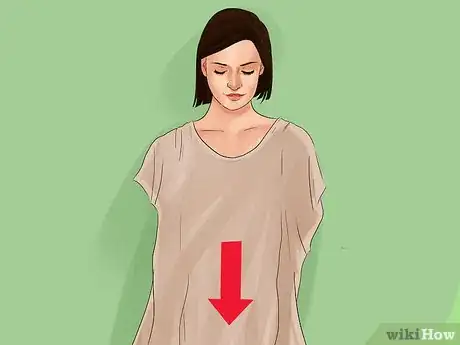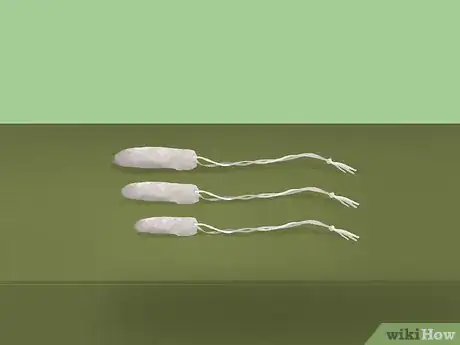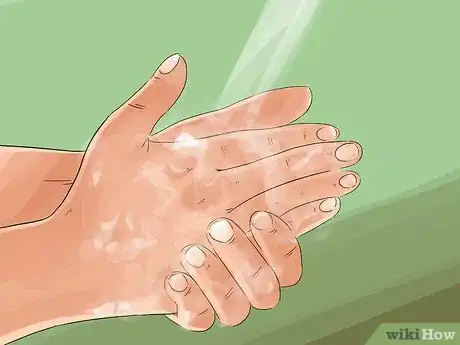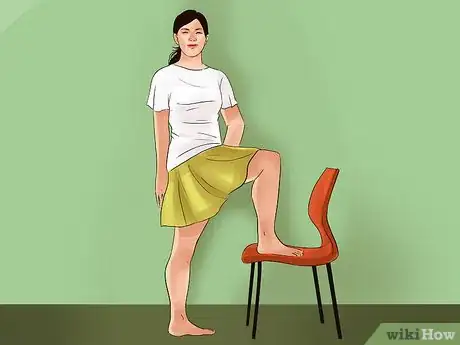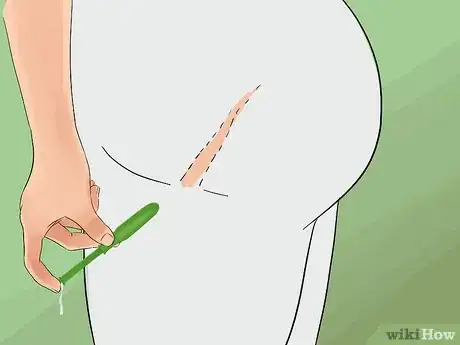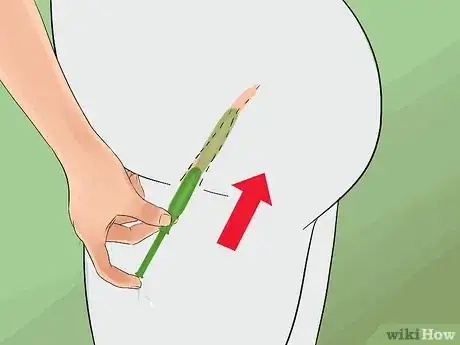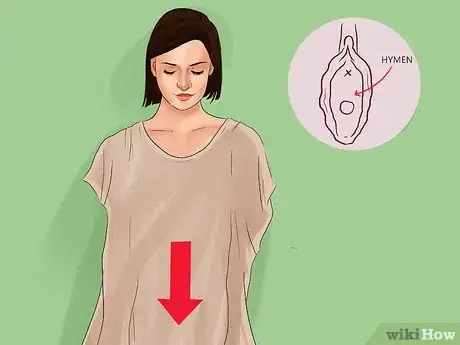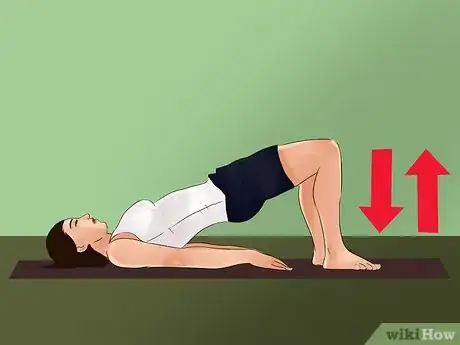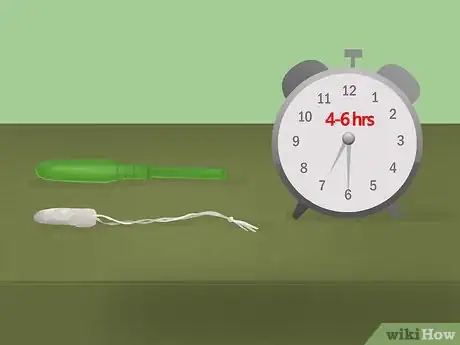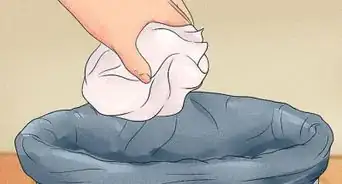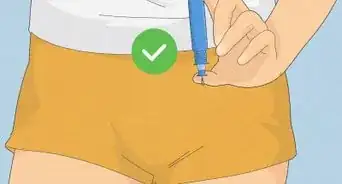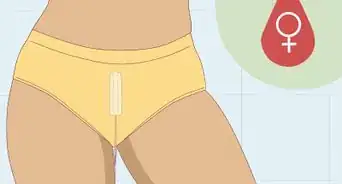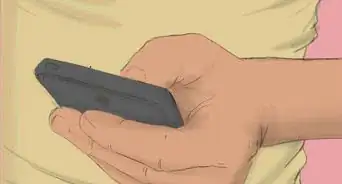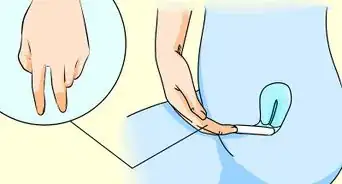This article was co-authored by Carrie Noriega, MD. Dr. Noriega is a Board Certified Obstetrician & Gynecologist and medical writer in Colorado. She specializes in women’s health, rheumatology, pulmonology, infectious disease, and gastroenterology. She received her MD from the Creighton School of Medicine in Omaha, Nebraska and completed her residency at the University of Missouri - Kansas City in 2005.
There are 10 references cited in this article, which can be found at the bottom of the page.
This article has been viewed 176,293 times.
If you use tampons, there will probably be times when the tampon is not going into the vagina the right way. This can result in pain. Having trouble getting a tampon comfortably inside your vagina is a common occurrence. Learn how to insert a tampon without pain so you can continue comfortably wearing them.
Steps
Choosing the Right Tampon
-
1Familiarize yourself with your vagina. One way to make sure you are inserting your tampon correctly is to make sure you understand how the tampon goes into your vagina. You may be able to feel around and stick the tampon inside, but you may not completely understand the mechanics. When you start using tampons, or if you have never looked at how they work, take the time to look at your genital area to get a better picture of what goes on when you use a tampon.[1]
- Get a mirror and look at your vagina so you have a good idea of the anatomy, where the tampon goes, and how it gets inserted before you start to insert a tampon.
-
2Use the applicator that is best for you. Tampons come with different kinds of applicators. You can get plastic applicators, cardboard applicators, or tampons without any applicator at all. You should try to figure out which is the best for you. For most women, a plastic applicator is easier to insert than others.[2]
- A plastic applicator has a slicker surface that may be easier to slide into the vagina. A tampon with a cardboard applicator or without any applicator may not slide as easily and get stuck or stop before it is completely inserted.
-
3Choose the right tampon size. Because a woman’s flow varies greatly, tampons come in different sizes and absorbencies. When choosing a tampon, you may want to go for a smaller tampon, especially if you are experiencing pain or having trouble inserting it properly. Try light or regular size tampons.[3]
- Each box explains the difference between the different tampon sizes. Light tampons are the smallest and most slender. They don’t absorb much blood, so if you are bleeding heavier, you may have to change your tampon more often. A regular tampon may also be a good option because it is still more slender but holds more menstrual blood.
- Super and super plus tampons may be too large to be comfortable. They are larger around because they are designed to hold blood from heavier flows.
- Make sure to use the absorbency that corresponds to your flow. Don’t use a larger tampon made for a heavier flow if you don’t need it.[4]
Inserting Your Tampon Properly
-
1Wash your hands and gather the supplies. Wash your hands thoroughly with soap and water before you insert your tampon. Dry your hands, making sure they are not damp. Unwrap the tampon and have it in a nearby, so it's easy to reach. Then, relax.[5]
- To relax, you can try some Kegel exercises first just to remind yourself to release the muscles. Contract then release your vaginal muscles three or four times.
- If the tampon has a paper applicator, you can try lubricating it with some vaseline, KY jelly, or mineral oil before inserting.[6]
-
2Get your body into position. Getting in the right position can help ease the process of inserting your tampon. One way you can position your body is to stand with your legs and knees apart. Another way that may help is to stand with one foot up on a stool, the edge of the toilet, or the edge of the bathtub or a chair.[7]
- If none of these makes you comfortable, you can try to lay on your back with your knees bent and your feet about shoulder width apart.
-
3Position the tampon just outside the vagina. Hold the tampon in your dominant hand. Hold the tampon at the middle, where the smaller tube inserts into the larger tube. Use your other hand to spread apart the labia, which are the flaps of tissue on either side of the vagina. Make sure to relax.[8]
- The string should be pointing away from your body because it will remain outside of the body and used to remove the tampon later.
- Remember, you can use a mirror to help guide you, especially the first few times.
-
4Insert the tampon. Place the top of the tampon applicator at the vaginal opening and gently push the tampon up to the point where you are touching your vagina. The tampon should be at an angle directed to the small of your back. Use the index finger of the hand holding the tampon to gently push on the smaller tube. Push gently until you feel a bit of resistance or the inner tube is completely in the outer tube.[9]
- Use your thumb and middle finger to pull out both tubes without touching the string.
- Avoid touching the string while you are inserting the tampon because the string should be moving along with the tampon up into the vaginal canal.
- Throw away the applicator and wash your hands when you are done.
- You should not be able to feel the tampon once it is inserted. If you do, remove it by pulling straight out using the string and insert another tampon.
- You can also try pushing the tampon higher up into your vagina to see if you can get it into a comfortable position. If this does not work, then pull it out and start over.
Determining If There Is An Underlying Medical Condition
-
1Determine if you still have an intact hymen. A hymen is perfectly normal and is usually a crescent piece of tissue that encircles part of the opening of the vagina. It may rip or tear during sexual intercourse, but also due to physical activity, injury or illness. If the hymen is intact, it can interfere with the insertion of a tampon and cause pain.[10]
- Sometimes, the hymen completely or nearly completely covers the vaginal opening. Other times, there is a strand or band of tissue that runs across the vaginal opening. If this strand is there, it can interfere with the insertion of a tampon, causing pain. See a doctor to get this checked out and to ask about having it removed.
-
2Decide if you tense when you try to insert your tampon. Another common problem women have with inserting tampons is that they get nervous and tense up. This is especially common if the woman has had a bad experience. The vaginal wall is lined with muscles and, just like any other muscle, can get tense. This can make the insertion of a tampon very uncomfortable and sometimes painful.
- Doing Kegel exercises has helped a number of women with tense vaginal muscles. Kegel exercises are a series of exercises which contract and relax the vaginal muscles. You do them exactly as you would if you were stopping the flow of urine and then allowing it to flow again. You can do these exercises anytime and anywhere.[11] Try for three sets of 10 contractions and releases every day.
-
3Replace the tampon often to prevent toxic shock syndrome (TSS). You should replace your tampon as needed. When you are awake, that may be every four to six hours, or more often depending on how heavy your flow is.[12] However, don’t leave a tampon in any longer than overnight. Tampons left in too long increase the risk of TSS. This is a rare infection that has been associated with tampon use. The symptoms of TSS include:[13]
- Flu-like symptoms, such as muscle and joint aches or headache.
- Sudden high fever
- Dizziness, fainting, or lightheadedness
- Vomiting
- A sunburn-like rash
- Diarrhea
-
4See your doctor. If the methods to help reduce the pain of inserting a tampon don’t work, you can make an appointment with your physician or gynecologist to see if there is a problem. For example, the hymen can easily be perforated and removed to allow free flow of menstrual blood, allow the use of a tampon, and make sexual intercourse much more comfortable. It is considered minor surgery and can usually be done in the doctor’s office.
- If tense vaginal muscles are the problem, the goal is to learn to control how tense the vaginal muscles are. If you need more help with this, talk to your physician about a treatment plan.
- If you have to have your doctor remove your hymen, this does not take away your virginity. Virginity is a state of experience, not a state of having an intact hymen.
- If you experience any of the symptoms of TSS, remove the tampon right away and get to your physician’s office or an emergency room. TSS can progress quickly and is a serious infection that needs immediate medical attention.
References
- ↑ http://youngwomenshealth.org/2012/09/27/tampons/
- ↑ https://obgyn.coloradowomenshealth.com/what-we-do/pediatric-teen-care/how-to-insert-tampon/
- ↑ http://youngwomenshealth.org/2012/09/27/tampons/
- ↑ http://www.pamf.org/teen/health/femalehealth/periods/tampons.html#Types & Sizes
- ↑ https://www.ubykotex.com.au/femcare-products/tampons/inserting/
- ↑ http://www.kidspot.com.au/parenting/teenager/teen-development/how-to-insert-a-tampon
- ↑ http://www.pamf.org/teen/health/femalehealth/periods/tampons.html#How to Use a Tampon
- ↑ http://tampax.com/en-us/tips-and-advice/my-first-tampon/how-to-insert-a-tampon
- ↑ https://obgyn.coloradowomenshealth.com/what-we-do/pediatric-teen-care/how-to-insert-tampon/
- ↑ http://youngwomenshealth.org/2013/07/10/hymens/
- ↑ http://www.mayoclinic.org/healthy-lifestyle/womens-health/in-depth/kegel-exercises/art-20045283
- ↑ https://obgyn.coloradowomenshealth.com/what-we-do/pediatric-teen-care/how-to-insert-tampon/
- ↑ http://www.mayoclinic.org/diseases-conditions/toxic-shock-syndrome/basics/definition/con-20021326
About This Article
While there will probably be times that your tampon doesn’t go in the right way, you can minimize the pain by familiarizing yourself with your vagina and finding tampons that work best for you. When you’re ready to insert the tampon, put one foot up on a chair or the edge of a toilet, relax your muscles, and slowly insert the tampon into the opening of your vagina, making sure it’s pointed at an angle toward your lower back. Consider trying tampons with plastic applicators first, as most women find the slickness makes it easier to insert than cardboard applicators. If you’re just starting to use tampons, get a mirror and look at your vagina to get a good idea of the anatomy and how a tampon is inserted. For more tips from our Medical co-author, including how to know if a medical condition is causing your pain, read on.
